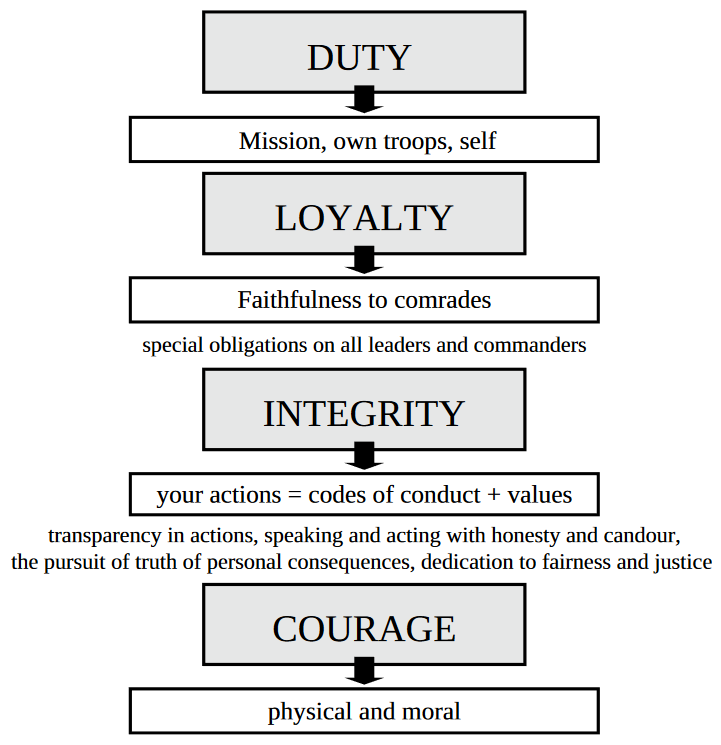Military Culture
A career in the Canadian military is deeply rooted in a commitment to service, embodying values of duty, loyalty, integrity, and courage. Individuals who choose this path do so with a profound understanding of dedicating themselves to the greater good of the nation. This dedication involves a willingness to face significant challenges, including the concept of unlimited liability, which signifies a readiness to risk one’s life in the line of duty.
Leadership
“Appointment to a position of superior rank and authority in the CF brings many responsibilities, including the expectation that the Officers, Warrant Officers, and NCOs entrusted with such authority will use it well, do their duty in accordance with the CF ethos, and prove to be good leaders. A significant part of being a good leader means acting in the interests of collective effectiveness and discharging the responsibilities of leadership—including the professional development of the next generation of leaders. But, at all rank levels, leaders in the CF are also expected to act like leaders—that is, to be ahead of issues and problems, to be dynamic, to actively apply their intelligence, imagination, and judgment, and to challenge the status quo with fresh ideas and disciplined independence.
Leaders are expected to take calculated risks. In this respect, a leader’s freedom of action is limited only by his or her imagination and resolve. Thus, in addition to carrying out assigned responsibilities capably and efficiently, effective CF leaders also use their intelligence, imagination, and initiative and do what they decide needs to be done to make their team, their unit, or the CF stronger and more effective. This is the broader meaning of duty as it applies to leaders in the CF” (National Defence, 2005, p. 41).

Military personnel are driven by a strong sense of purpose and a commitment to the team, the mission, and the successful execution of their duties. This dedication fosters a culture where collaboration and mutual support are paramount. Service members understand their role is about contributing to the success of the team and the fulfillment of the mission, ensuring operational success and maintaining vital trust and camaraderie.
Watch CAF Story | Get Out the Door (5 mins) on YouTube
Video source: Canadian Armed Forces. (2023b, August 31). CAF story | Get out the door [Video]. YouTube. https://www.youtube.com/watch?v=okleu_DBR14
Professionalism in the Canadian military is exemplified by strict adherence to discipline, punctuality, and respect for authority. Being on time is fundamental, with arriving 15 minutes early considered the norm. Additionally, paying full attention when an instructor, commanding officer, or higher-ranked Non-Commissioned Member (NCM) is speaking is crucial. This level of professionalism maintains the standards and effectiveness of the Canadian Armed Forces.
Best Practices in Student Veteran Education: Making a “Veteran-Friendly” Institution.
“While it would appear that student veterans have all of the advantages necessary for academic success, the statistics regarding retention rates would indicate otherwise. In the initial years after the implementation of the post-9/11 GI Bill, alarmists indicated that student veteran dropout rates were as high as 88% after the first year (Wood, 2012). However, more recent analysis puts student veteran graduation rates closer to 52%, which is dramatically better, but still far below traditional students, which is a concern (Zoroya, 2014). Despite the inherent values such as maturity, responsibility, and accountability gained through military service, student veterans also frequently have to deal with obstacles such as post-traumatic stress disorder (PTSD), traumatic brain injury (TBI), and family and work concerns. Perhaps the greatest stumbling block of all is the culture shock associated with military to-academic transitions, which has a tendency to leave otherwise, successful student veterans feeling isolated and confused upon their arrival on campus” (Dilland and Yu, 2016, p. 182).
Conclusion
Becoming a member of the Canadian Armed Forces is filled with challenges from the day a recruit sets out on basic training to the day that member hands their uniform back in at supply and becomes a veteran. Each step involves significant sacrifice, not only from the member but also from the members spouse, kids, and extended family. Facing the dread of upcoming deployments and exercises, as well as the relief of returning home safe and sound. The CAF is a career like no other, demanding resilience and dedication. Those transitioning into the post-secondary world after their military service deserve recognition and support. Navigating a new career while carrying the experiences of military life requires understanding and assistance from all educational institutions.
Attribution & References
Except where otherwise noted, this page was created by Jason Kerr and is licensed under CC BY-NC-ND 4.0.
References
Dillard, R. J., & Yu, H. H. (2016). Best practices in student veteran education: Making a “veteran-friendly” institution. The Journal of Continuing Higher Education, 64(3), 181–186. https://doi.org/10.1080/07377363.2016.1229106
Malinowski, P. (2016). Canadian Model of Military Leadership as a Successful Mixture of Civilian and Military Experiences. Journal of Corporate Responsibility and Leadership, 2(1), 77. https://doi.org/10.12775/jcrl.2015.005
National Defence. (2005). Leadership in the Canadian Forces: Doctrine. https://publications.gc.ca/collections/collection_2013/dn-nd/D2-313-1-2005-eng.pdf

